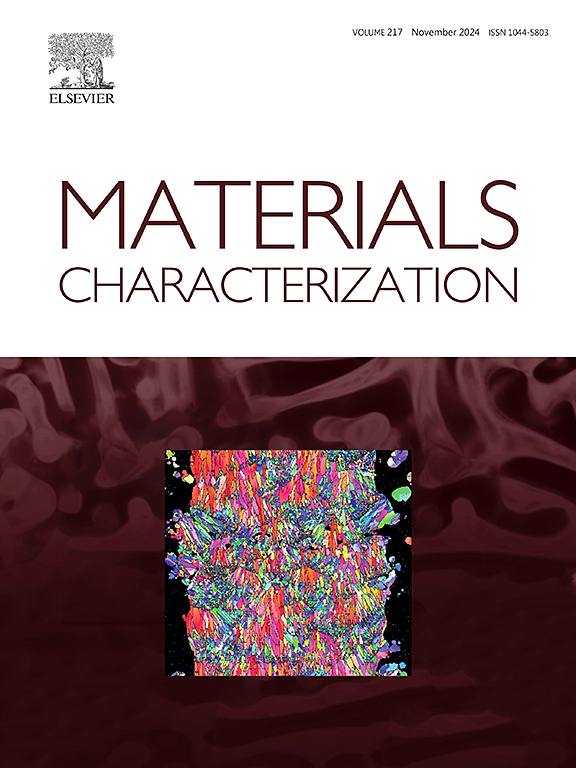增材制造A205合金的显微组织演变和力学行为:制造状态和热处理状态
IF 4.8
2区 材料科学
Q1 MATERIALS SCIENCE, CHARACTERIZATION & TESTING
引用次数: 0
摘要
采用TiB2纳米颗粒接种的高强度Al-Cu-Mg-Ag-(Ti)合金A205,通过激光粉末床熔合(LPBF)和T7后处理制备了单杠。利用各种先进的电子显微镜技术对制备和热处理样品的微观结构特征进行了评估。研究结果表明,激光粉末床熔合引起的热过冷增加诱导了大量TiB2孕育剂的活化,促进了非均相成核。该工艺降低了样品的平均晶粒尺寸,达到了细化水平,使制造的材料被归类为超细晶粒材料。采用T7热处理,包括固溶退火和随后的人工时效,导致晶粒生长不均匀,并在组织内形成多种强化元素,包括GP区,θ ", θ '和Ω相。这种复杂的微观组织演变对材料的力学性能有显著的影响。在热处理后的样品中,不再观察到不连续屈服,并且观察到极限抗拉强度大幅提高75%以上。然而,这些强度的增加伴随着延性的降低,突出了强度增加和延性降低之间的权衡。在热处理(HTed)样品中观察到的延展性显著下降(~ 74%)可归因于沿晶界的无析出区(PFZs)内出现的金属间化合物(IMCs)。本文章由计算机程序翻译,如有差异,请以英文原文为准。
Microstructural evolution and mechanical behavior in additively manufactured A205 alloy: as-built and heat-treated conditions
A TiB2 nanoparticle-inoculated high-strength Al-Cu-Mg-Ag-(Ti) alloy known as A205 was employed to manufacture horizontal bars through laser powder bed fusion (LPBF) and post-processed with T7 heat treatment. The microstructural characteristics of both the fabricated and heat-treated samples were assessed using various advanced electron microscopy techniques. The findings indicated that increased thermal supercooling caused by laser powder-bed fusion induced the activation of a multitude of TiB2 inoculants facilitating heterogeneous nucleation. This process reduced the average grain size within the as-built samples, reaching a refinement level that allows the manufactured materials to be classified as ultra-fine grain materials. The application of T7 heat treatment, encompassing solution annealing and subsequent artificial aging, resulted in uneven grain growth and the formation of diverse strengthening elements within the microstructure including GP zones, θ”, θ’, and Ω phases. This intricate microstructural evolution had a notable impact on the mechanical properties. In the heat-treated samples, discontinuous yielding was no longer observed, and substantial enhancements in ultimate tensile strength of over 75 % were observed. However, these strength gains were accompanied by a reduction in ductility highlighting a trade-off between increased strength and decreased ductility. The significant decline in ductility observed in the heat-treated (HTed) samples (∼74 %) can be attributed to the emergence of intermetallic compounds (IMCs) within the precipitation-free zones (PFZs) along the grain boundaries.
求助全文
通过发布文献求助,成功后即可免费获取论文全文。
去求助
来源期刊

Materials Characterization
工程技术-材料科学:表征与测试
CiteScore
7.60
自引率
8.50%
发文量
746
审稿时长
36 days
期刊介绍:
Materials Characterization features original articles and state-of-the-art reviews on theoretical and practical aspects of the structure and behaviour of materials.
The Journal focuses on all characterization techniques, including all forms of microscopy (light, electron, acoustic, etc.,) and analysis (especially microanalysis and surface analytical techniques). Developments in both this wide range of techniques and their application to the quantification of the microstructure of materials are essential facets of the Journal.
The Journal provides the Materials Scientist/Engineer with up-to-date information on many types of materials with an underlying theme of explaining the behavior of materials using novel approaches. Materials covered by the journal include:
Metals & Alloys
Ceramics
Nanomaterials
Biomedical materials
Optical materials
Composites
Natural Materials.
 求助内容:
求助内容: 应助结果提醒方式:
应助结果提醒方式:


